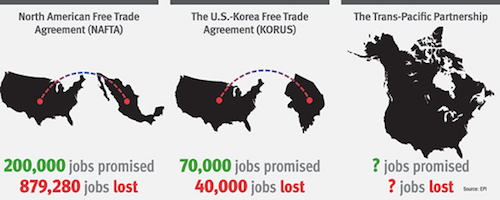The non-partisan U.S. International Trade Commission issued a report predicting the Trans-Pacific Partnership would lead to barely noticeable gains in the U.S. economy.
The ITC also predicted that the energy and manufacturing
sectors, which employ more than 300,000 IBEW members, will be $11 billion
smaller if the TPP passes.

|
| Economic models predicting the impact of “free” trade agreements have always overstated the positive and the understated the downside. The tiny economic boost predicted for the TPP is a cause for concern for organized labor.
|
The Trans-Pacific Partnership is a “free” trade deal
negotiated among the U.S. and Australia, Brunei, Canada, Chile, Japan,
Malaysia, Mexico, New Zealand, Peru, Singapore and Vietnam. It would lower
barriers to trade, and would weaken labor, environmental and free speech protections.
To become law, the treaty needs majority approval in both
houses of Congress and passage has been a White House priority for the final
year of Obama’s presidency. The treaty has been opposed by organized labor,
environmentalists and many members of the president’s own party.
International President Lonnie R. Stephenson said the ITC
report confirms the IBEW’s long held position that TPP is a bad deal and a
distraction.
“The worst part is we know how to improve the situation of
working families: rebuild our infrastructure,” Stephenson said. “And you don’t
have to take my word for it. The neoliberal economists at the International
Monetary Fund have been pushing free trade agreements for decades and even they
said one percent of GDP invested in infrastructure leads to four percent growth
within four years. Compare that to less than one percent gain over 20 years.”
The highest-ranking Democrat on the House Ways and Means
Committee, Rep. Sander Levin of Michigan, said the ITC report “confirms my
position that I cannot support TPP as negotiated.”
In a statement released
by his office
, Levin criticized the model used by the ITC, saying it was
“based on an optimistic assumption that our trading partners will open their
markets to our exports, rather than simply replacing their existing tariff
barriers with new non-tariff barriers, even though we have repeatedly seen that
happen in the past.”
Before NAFTA became law in 1994, the ITC predicted there
would be “minor negative impact” on U.S. auto production, no change in auto
production employment, and no “appreciable” decline in employment in the
electronics production sector.
Rep. Louise Slaughter of New York said the trade report is
“just the latest in [the ITC’s] long line of rose-colored forecasts on the
economic impact of free trade agreements.”
The ITC assumed that everyone who loses their job could
instantly find another one at the same salary because of “increased
efficiencies” due to freer trade. The ITC model also assumed that higher worker
productivity will translate to an equal increase in wages, despite decades of
evidence to the contrary. The ITC model also assumes only positive effects from
the food and worker safety rules, consumer protections and banking regulations
that will be stripped away under the deal.
A spokesperson for the Chamber of Commerce, however,
“welcomed” the ITC report. In
a statement from Myron Brilliant, U.S. Chamber executive vice president,
wrote the report “provides substantive support for the Chamber’s view that the
TPP is in our national economic interest.”
Despite the support of some in the business community, TPP has
been criticized by presidential candidates Hillary Clinton, Bernie Sanders and
Donald Trump. The Wall Street Journal
reported
this week
that the Congress is unlikely to consider the deal before the
November election.
“Experience teaches
us to expect magical claims from the people selling us free trade deals,” said
International President Lonnie R. Stephenson. “They are using just as much
smoke and just as many mirrors, but the trick is failing, and we’re not
fooled.”